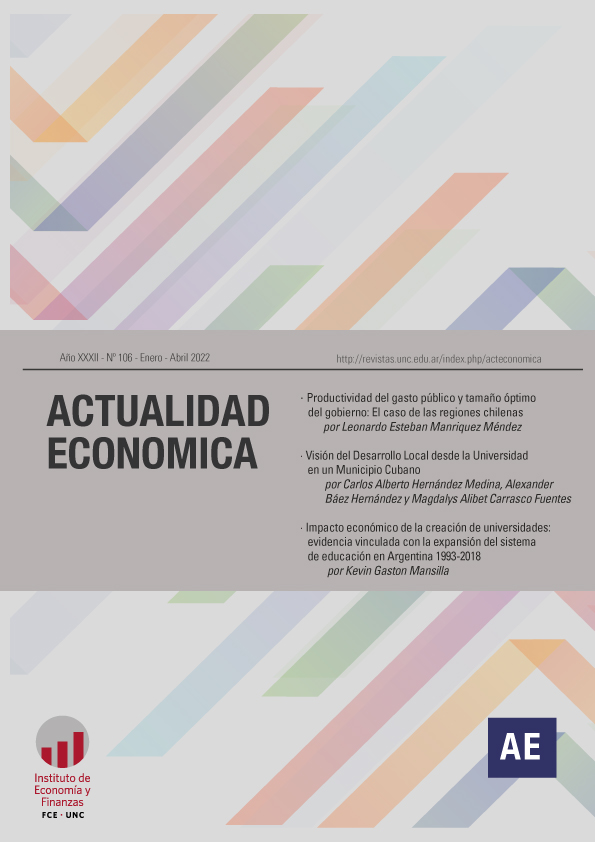Productivity of public expenditure and optimal government size: The case of the chilean regions
Keywords:
public expenditure, productivity of public expenditure, optimal government sizeAbstract
The understanding of the structure and behavior of the government, in the economy, strengthen and guide benign public policies for economic and social well-being. For this, in this paper the optimal, size of government for the economics of the chilean regional governments is estimated through the methodology employed by Karras (1996). The results show the existence of productive public spending in the Chilean regions and consider that in the case of regions with greater economic development, public spending is under-provided and in regions with less economic development, over-provisioned. The optimal national size of government for regional economies is 4.84% and, specifically, 5.8% for regions with greater economic development and 4.0% for regions with less economic development. In this context, an inverse relationship was found between the productivity of public spending and the size of government for regions with greater economic development. The size of the Chilean regional governments is below the estimated optimal level, with the exception of two regions. Therefore, for regions that do not reach the optimum, there is room for an increase in public spending in a benign way for economic growth.
Downloads
References
Adam C, Bevan D (2005) Fiscal deficits and growth in developing countries. J Public Econ 89(4):571–597
Afonso A, González Alegre J (2011) Economic growth and budgetary components: a panel assessment for the EU. Empir Econ 41:703–723
Aly, H., & Strazicich, M. (2000). Is Government Size Optimal in the Gulf Countries of the Middle East? An empirical investigation. International Review of Applied Economics, 14, 475-483. https://doi.org/10.1080/02692170050150147
Anwar, S. (2003). Increased Input Supplies, Government Size, Welfare and Trade in the Presence of Increasing Returns. Journal of Economics, 78(3), 259-272.
Bairam, E. (1995). Externality effect of the USA total, federal and state government expenditures on private investment, 1960-91. Applied Economics Letters, 2(1), 23-25. https://doi.org/10.1080/135048595357753
Bairam, E., & Ward, B. (1993). The externality effect of government expenditure on investment in OECD countries. Applied Economics, 25(6), 711-716. https://doi.org/10.1080/00036849300000123
Barro, R. J. (1990). Government Spending in a Simple Model of Endogeneous Growth. Journal of Political Economy, 98(5, Part 2), 103-125. https://doi.org/10.1086/261726
Bartik, T. (1994). Jobs, productivity, and local economic development: What implications does economic research have for the role of government? National Tax Journal, 47(4), 847-861.
Brennan, G., & Buchanan, J. (1980). The power to tax: Analytical foundation of a fiscal constitution. New York: Cambridge University Press.
Christie T (2012) The effect of government spending on economic growth: testing the non-linear hypothesis. Bull Econ Res 66(2):183–204
De Gregorio, J. (2005). Crecimiento económico en Chile: Evidencia, fuentes y perspectivas. Estudios públicos, 98. Recuperado de https://www.cepchile.cl/cep/site/artic/20160304/asocfile/20160304093619/r98_degregorio_crecimi-economic.pdf
Easterly, W. (2001). The elusive quest for growth: Economists adventures and misadventures in the tropics. Cambridge, Mss: MIT Press.
Gupta S, Clements B, Baldacci E, Mulas-Granados C (2005) Fiscal policy, expenditure composition and growth in low-income countries. J Int Money Finance 24(3):441–463
Idrovo, B. (2012). Inversión en la infraestructura pública y crecimietno económico, evidencia para Chile. Munich Personal RePEc Archive, (69). Recuperado de https://mpra.ub.uni-muenchen.de/39857/
Karras, G. (1996). The optimal government size: Further international evidence on the productivity of governmente services. Economic Inquiry, 34, 193-203. https://doi.org/10.1111/j.1465-7295.1996.tb01372.x
Kneller R, Bleaney M, Gemmell N (1999) Fiscal policy and growth: evidence from OECD countries. J Public Econ 74(2):171–190
Landau, D. (1983). Government expenditure and economic growth: A cross-country study, 49(3), 783-792. https://doi.org/10.2307/1058716
Montes de Oca, J. (2008). Productividad y tamaño óptimo de gobierno: El caso de los gobiernos estatales en México. Ensayos, XXVll, 111-130.
Qian, Y., & Roland, G. (1998). Federalism and the Soft Budget Constraint. The American Economic Review, 88(5), 1143-1162.
Ram, R. (1989). Government Size and Economic Growth: A New Framework and Some Evidence from Cross-Section and Time-Series Data: Reply. The American Economic Review, 79(1), 281-284.
Woller, G. M., & Phillips, K. (1998). Fiscal decentralisation and IDC economic growth: An empirical investigation. Journal of Development Studies, 34(4), 139-148. https://doi.org/10.1080/00220389808422532
Downloads
Published
Issue
Section
License

This work is licensed under a Creative Commons Attribution-NonCommercial-NoDerivatives 4.0 International License.
Those authors who have published with this journal, accept the following terms:
Authors will conserve their copyright and guarantee the magazine the right of first publication of their work, which will be simultaneously subject to the Creative Commons Attribution-NonCommercial-NoDerivative 4.0 International License that allows third parties to share the work as long as the author and first publication of this magazine are indicated.
Authors may adopt other non-exclusive license agreements to distribute the published version of the work (e.g., deposit it in an institutional telematic archive or publish it in a monographic volume) provided that the initial publication in this journal is indicated.
Authors are allowed and encouraged to disseminate their work through the Internet (e.g., in institutional telematic archives or on their website) before and during the submission process, which may lead to interesting exchanges and increase citations of the published work. (See The effect of open access)









